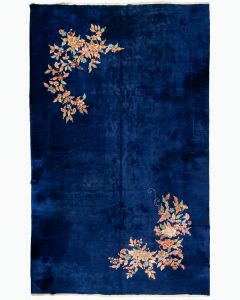Chinese Art Deco Rugs
As the term implies, true Chinese Deco carpets were woven in a short time window, between 1923 and 1931, and in two places: the Chinese capital of Peking (Beijing) and the northeastern city of Tientsin (Tianjin). They were woven in large integrated factories as well as smaller workshops. These carpets were created by American firms for export to the United States. Nichols, Elbrook and Tavshanjian in Tientsin, and Fette in Peking were by far the most active. The Tientsin pieces, almost all in carpet sizes, show thick piles of glossy millspun wool, patterns ranging from Chinese-influenced with vases, leafy branches, seasonal flowers and butterflies, and dragons to wholly abstract, borderless creations with moss and bottle green, scarlet, fuchsia, beige, old gold and various shades of blue, all in unfading, crisp chrome dyes. Many are found still in top condition. The weaves are always moderate to medium, and very regular. There is no uniformity of pattern and most of the surviving carpets are unique.
The Peking pieces are lighter in both tone and weight, with softer shades of blue, teal, cream and coral important. Borders are essential, but vertical pattern symmetry is optional. Oval, round and other esoteric shapes are common. Peacocks are a recurring motif. If one wants an oval piece suitable for a bedroom, Fette is the only way to go. The weaving is of moderate to medium texture, and anything from tiny round ruglets with land scape and animal vignette designs to very Chinese-looking room sizes are available. They are not packed as tightly as Tientsin carpets. Pictorials with Chinese scenes adapted from scroll paintings are most often found in Fette carpets. The integrated company was active in the twenties.
Both Peking and Tientsin firms employed local artists, with weavers closely following the cartoons. In neither place do we find the informal touches often found in Persian pieces. The Depression, with the radical contraction of the American market ,and the Japanese invasion of northern China, effectively finished off this brilliant period of unique Chinese carpet-making. Carpet weaving, in entirely new forms, did not revive in China until after the tumultuous Mao period.











